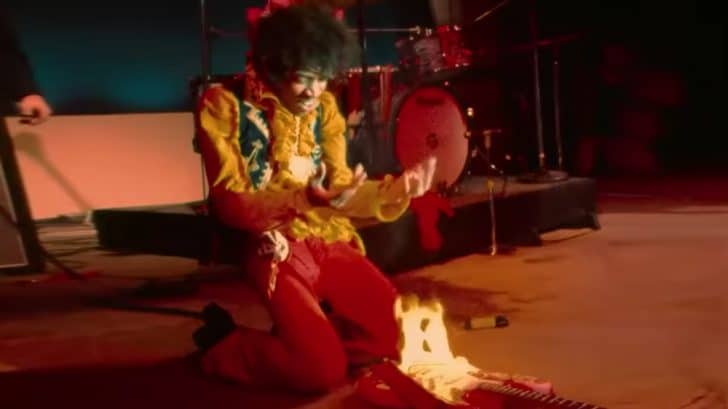In the vibrant tapestry of rock and roll history, certain moments transcend the boundaries of time and become enshrined as symbols of rebellion, innovation, and raw artistic expression. One such moment unfolded on a balmy summer evening in 1967 at the Monterey Pop Festival, a gathering that would come to define an era.
It was during this electrifying event that Jimi Hendrix, the guitar virtuoso who would soon become an icon, seized the attention of thousands with a display of audacity that remains etched in the collective memory of music enthusiasts worldwide: he set his guitar ablaze.
This audacious display definitely paid off, and Hendrix became a star. As people and fans quickly found out later, this rock legend isn’t just a gimmicky guitar-burning dude: Jimi Hendrix is more remembered as the instrument’s virtuoso and musical innovator.
The ritual act of musical destruction was immortalized on tape during the Monterey Pop, but it was actually the second time Jimi burned his guitar. People to this day are still mesmerized by the act and often wondered why did he do it.
Was it merely an exhibition of showmanship, a stunning spectacle designed to captivate the audience? Or did it carry a deeper, symbolic meaning, representing a rebellion against musical conventions and a desire to forge new frontiers? Or could it have been a heartfelt tribute to the blues, paying homage to the genre’s tradition of fervor and intensity?
Showmanship and Performance Art
And it started with Jimi accidentally cracking his guitar. Early in 1967, he and his band embarked on a European tour. The cracked guitar fell victim to some good ol’ smashing, something rockstars were wont to do.
The Who’s Pete Townshend was the prominent guitar smasher during that time, and Jimi felt that he need to step up his game. The latter will probably find it hard to match Townshend’s wake of destruction though: As revealed by TheWho.net, the English band’s guitarist broke more than 35 guitars in 1967 alone. Yikes.
View this post on Instagram
In March of the same year, during a British tour with bigger artists the likes of Englebert Humperdinck, Cat Stevens, and The Walker Brothers, Jimi knew he had to do something. After a brainstorming session with manager Chas Chandler, that something has a lot to do with fire.
During the Jimi Hendrix Experience’s rendition of “Fire”, Jimi put his guitar down by an amplifier and Chandler doused it with lighter fluid. Bassist Noel Redding and drummer Mitch Mitchell played on as the spectacle slowly unfolded.
In front of a curious audience in Finsbury Park Astoria, Jimi lit up a match and set fire to his guitar, a scene that would mesmerize a generation of rock fans. “That is how ‘guitar flame’ was born,” shares rock journalist Keith Altham, who was actually the purveyor of the idea.
“I was backstage at Finsbury Park Astoria… Chas turned to me at one point and said ‘how are we going to steal the headlines this week?’ So I said ‘you can’t keep smashing the guitar because people will just say you’re copying The Who and The Move, you got to find something original to do – why don’t you set fire to the guitar?’”
After a bout of silence, Chandler had his PA Tony Garland buy some lighter fuel. And the rest was one of rock history’s most memorable live acts.
Jimi Hendrix and his band did not burn any guitars during the Walker Brothers tour though, after being shunned and ill-treated by the pop group after their attention-grabbing ‘guitar flame’.
But Jimi was far from done. He would later explain: “I decided to destroy my guitar at the end of a song as a sacrifice. You sacrifice things you love. I love my guitar.”
The ground-breaking guitarist would of course repeat the fiery performance at the legendary Monterey Pop in June 1967, where he would even more grab heads as the guitar-burning ritual was immortalized on video.
As the Jimi Hendrix Experience reached the climax of their rendition of The Troggs’ “Wild Thing”, Jimi kissed his hand-painted Stratocaster as if saying goodbye, doused it in fluid, and lit it all up with a match.
Our guitar crush this week goes to The Jimi Hendrix Monterey Stratocaster. This limited model faithfully replicates Jimi’s hand-painted psychedelic artwork on the body of the guitar. #jimihendrix #montereystratocaster #stratocaster #saguitarist #sabands #samusicians #fenderza pic.twitter.com/d2NwvFDKTl
— SAguitaristMag (@SAguitaristMag) November 21, 2019
He then proceeded to smash the guitar and tossed the charred remains onto the crowd.
Fellow Monterey performers Pete Townshend and Mama Cass of The Papas & Mamas saw the performance from the crowd. Mama Cass teased Pete saying “he’s stealing your act”, and the latter replied, “no, he’s not stealing my act – he’s doing my act.”
There were accounts that also aptly described the difference between the two legendary guitarists guitar-destroying antics: Hendrix makes love while Townshend was committing abuse.
The act of burning his guitar during his Monterey Pop Festival performance was a pinnacle moment of Hendrix’s showmanship. The fire became an extension of Hendrix’s energy and passion, symbolizing the intensity of his music and the boundary-breaking nature of his artistry.
The Enduring Legacy and Iconic Image
The impact of Hendrix’s guitar-burning act on his reputation cannot be overstated. It became a defining moment in his career, solidifying his image as a trailblazer and a true icon of rock and roll.
Jimi Hendrix lighting his guitar on fire at the Monterey Pop Festival, 1967. #JimiHendrix pic.twitter.com/sKEP5aTf1H
— Classic Rock In Pics (@crockpics) June 16, 2019
Beyond its immediate impact, Hendrix’s ‘guitar flame’ has left a lasting legacy. It continues to inspire musicians and fans alike, a symbol of artistic liberation and the relentless pursuit of pushing boundaries.
The audacious act serves as a reminder that music is not merely confined to sound, but can transcend into a multi-sensory experience that resonates deeply with the audience.

